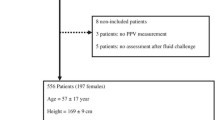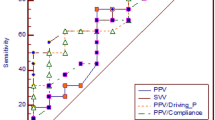Abstract
The accuracy of pulse pressure variation (PPV) to predict fluid responsiveness using pressure-controlled (PC) instead of volume-controlled modes is under debate. To specifically address this issue, we designed a study to evaluate the accuracy of PPV to predict fluid responsiveness in severe septic patients who were mechanically ventilated with biphasic positive airway pressure (BIPAP) PC-ventilation mode. 45 patients with sepsis or septic shock and who were mechanically ventilated with BIPAP mode and a target tidal volume of 7–8 ml/kg were included. PPV was automatically assessed at baseline and after a standard fluid challenge (Ringer’s lactate 500 ml). A 15% increase in stroke volume (SV) defined fluid responsiveness. The predictive value of PPV was evaluated through a receiver operating characteristic (ROC) curve analysis and “gray zone” statistical approach. 20 (44%) patients were considered fluid responders. We identified a significant relationship between PPV decrease after volume expansion and SV increase (spearman ρ = − 0.5, p < 0.001). The area under ROC curve for PPV was 0.71 (95%CI 0.56–0.87, p = 0.007). The best cut-off (based on Youden’s index) was 8%, with a sensitivity of 80% and specificity of 60%. Using a gray zone approach, we identified that PPV values comprised between 5 and 15% do not allow a reliable fluid responsiveness prediction. In critically ill septic patients ventilated under BIPAP mode, PPV appears to be an accurate method for fluid responsiveness prediction. However, PPV values comprised between 5 and 15% constitute a gray zone that does not allow a reliable fluid responsiveness prediction.



Similar content being viewed by others
Data availability
The datasets used and/or analyzed during the current study are available from the corresponding author on reasonable request.
References
Vallee F, Richard JC, Mari A, Gallas T, Arsac E, Verlaan PS, et al. Pulse pressure variations adjusted by alveolar driving pressure to assess fluid responsiveness. Intensive Care Med. 2009;35:1004–10.
Freitas FG, Bafi AT, Nascente AP, Assuncao M, Mazza B, Azevedo LC, Machado FR. Predictive value of pulse pressure variation for fluid responsiveness in septic patients using lung-protective ventilation strategies. Br J Anaesth. 2013;110:402–8.
Hofer CK, Geisen M, Hartnack S, Dzemali O, Ganter MT, Zollinger A. Reliability of passive leg raising, stroke volume variation and pulse pressure variation to predict fluid responsiveness during weaning from mechanical ventilation after cardiac surgery: a prospective, observational study. Turk J Anaesthesiol Reanim. 2018;46:108–15.
Grassi P, Lo Nigro L, Battaglia K, Barone M, Testa F, Berlot G. Pulse pressure variation as a predictor of fluid responsiveness in mechanically ventilated patients with spontaneous breathing activity: a pragmatic observational study. HSR Proc Intensive Care Cardiovasc Anesth. 2013;5:98–109.
Teboul JL, Vieillard-Baron A. Clinical value of pulse pressure variations in ARDS. Still an unresolved issue? Intensive Care Med. 2005;31:499–500.
Derichard A, Robin E, Tavernier B, Costecalde M, Fleyfel M, Onimus J, Lebuffe G, Chambon JP, Vallet B. Automated pulse pressure and stroke volume variations from radial artery: evaluation during major abdominal surgery. Br J Anaesth. 2009;103:678–84.
Cannesson M, Slieker J, Desebbe O, Bauer C, Chiari P, Hénaine R, Lehot J-J. The ability of a novel algorithm for automatic estimation of the respiratory variations in arterial pulse pressure to monitor fluid responsiveness in the operating room. Anesth Analg. 2008;106:1195.
Cannesson M, Le Manach Y, Hofer CK, Goarin JP, Lehot JJ, Vallet B, Tavernier B. Assessing the diagnostic accuracy of pulse pressure variations for the prediction of fluid responsiveness: a “gray zone” approach. Anesthesiology. 2011;115:231–41.
Beloncle F, Rozé H, Mortaza S, Mercat A, Richard JCM. Ventilation spontanée au cours du syndrome de détresse respiratoire aiguë. Méd Intensive Réanim. 2017;26:155–60.
Zhou Y, Jin X, Lv Y, Wang P, Yang Y, Liang G, Wang B, Kang Y. Early application of airway pressure release ventilation may reduce the duration of mechanical ventilation in acute respiratory distress syndrome. Intensive Care Med. 2017;43:1648–59.
Teboul J-L, Monnet X, Chemla D, Michard F. Arterial pulse pressure variation with mechanical ventilation. Am J Respir Crit Care Med. 2018;199:22–31.
Alvarado Sánchez JI, Caicedo Ruiz JD, Diaztagle Fernández JJ, Ospina-Tascón GA, Cruz Martínez LE. Use of pulse pressure variation as predictor of fluid responsiveness in patients ventilated with low tidal volume: a systematic review and meta-analysis. Clin Med Insights Circ Respir Pulm Med. 2020;14:1179548420901518–1179548420901518.
Soubrier S, Saulnier F, Hubert H, Delour P, Lenci H, Onimus T, Nseir S, Durocher A. Can dynamic indicators help the prediction of fluid responsiveness in spontaneously breathing critically ill patients? Intensive Care Med. 2007;33:1117–24.
Singer M, Deutschman CS, Seymour CW, Shankar-Hari M, Annane D, Bauer M, et al. The third international consensus definitions for sepsis and septic shock (sepsis-3). JAMA. 2016;315:801–10.
Bataille B, de Selle J, Moussot PE, Marty P, Silva S, Cocquet P. Machine learning methods to improve bedside fluid responsiveness prediction in severe sepsis or septic shock: an observational study. Br J Anaesth. 2021;126:826–34.
Vieillard-Baron A, Prin S, Chergui K, Dubourg O, Jardin F. Echo-Doppler demonstration of acute cor pulmonale at the bedside in the medical intensive care unit. Am J Respir Crit Care Med. 2002;166:1310–9.
Biais M, Ehrmann S, Mari A, Conte B, Mahjoub Y, Desebbe O, et al. Clinical relevance of pulse pressure variations for predicting fluid responsiveness in mechanically ventilated intensive care unit patients: the grey zone approach. Crit Care. 2014;18:587.
Evans L, Rhodes A, Alhazzani W, Antonelli M, Coopersmith CM, French C, et al. Surviving sepsis campaign: international guidelines for management of sepsis and septic shock 2021. Intensive Care Med. 2021;47:1181–247.
Kattan E, Ospina-Tascon GA, Teboul JL, Castro R, Cecconi M, Ferri G, Bakker J, Hernandez G. Systematic assessment of fluid responsiveness during early septic shock resuscitation: secondary analysis of the ANDROMEDA-SHOCK trial. Crit Care. 2020;24:23.
Monnet X, Marik PE, Teboul J-L. Prediction of fluid responsiveness: an update. Ann Intensive Care. 2016;6:111.
Aboy M, McNames J, Thong T, Phillips CR, Ellenby MS, Goldstein B. A novel algorithm to estimate the pulse pressure variation index deltaPP. IEEE Trans Biomed Eng. 2004;51:2198–203.
Rose L, Hawkins M. Airway pressure release ventilation and biphasic positive airway pressure: a systematic review of definitional criteria. Intensive Care Med. 2008;34:1766–73.
Lamia B, Ochagavia A, Monnet X, Chemla D, Richard C, Teboul JL. Echocardiographic prediction of volume responsiveness in critically ill patients with spontaneously breathing activity. Intensive Care Med. 2007;33:1125–32.
Mahjoub Y, Benoit-Fallet H, Airapetian N, Lorne E, Levrard M, Seydi AA, Amennouche N, Slama M, Dupont H. Improvement of left ventricular relaxation as assessed by tissue Doppler imaging in fluid-responsive critically ill septic patients. Intensive Care Med. 2012;38:1461–70.
Muller L, Bobbia X, Toumi M, Louart G, Molinari N, Ragonnet B, et al. Respiratory variations of inferior vena cava diameter to predict fluid responsiveness in spontaneously breathing patients with acute circulatory failure: need for a cautious use. Crit Care. 2012;16:R188.
Charbonneau H, Riu B, Faron M, Mari A, Kurrek MM, Ruiz J, et al. Predicting preload responsiveness using simultaneous recordings of inferior and superior vena cavae diameters. Crit Care. 2014;18:473.
Ferdhiana R, Terpstra J, Magel RC. A nonparametric test for the ordered alternative based on Kendall’s correlation coefficient. Commun Stat Simul Comput. 2008;37:1117–28.
Brower RG, Matthay MA, Morris A, Schoenfeld D, Thompson BT, Wheeler A. Ventilation with lower tidal volumes as compared with traditional tidal volumes for acute lung injury and the acute respiratory distress syndrome. N Engl J Med. 2000;342:1301–8.
Fuller BM, Mohr NM, Carpenter CR. Protective ventilation for patients without acute respiratory distress syndrome. JAMA. 2013;309:654–5.
Michard F, Boussat S, Chemla D, Anguel N, Mercat A, Lecarpentier Y, Richard C, Pinsky MR, Teboul JL. Relation between respiratory changes in arterial pulse pressure and fluid responsiveness in septic patients with acute circulatory failure. Am J Respir Crit Care Med. 2000;162:134–8.
Michard F, Teboul JL. Predicting fluid responsiveness in ICU patients: a critical analysis of the evidence. Chest. 2002;121:2000–8.
Castro R, Kattan E, Ferri G, Pairumani R, Valenzuela ED, Alegría L, et al. Effects of capillary refill time-vs. lactate-targeted fluid resuscitation on regional, microcirculatory and hypoxia-related perfusion parameters in septic shock: a randomized controlled trial. Ann Intensive Care. 2020;10:150.
Bataille B, Rao G, Cocquet P, Mora M, Masson B, Ginot J, Silva S, Moussot PE. Accuracy of ultrasound B-lines score and E/Ea ratio to estimate extravascular lung water and its variations in patients with acute respiratory distress syndrome. J Clin Monit Comput. 2015;29:169–76.
Komorowski M, Celi LA, Badawi O, Gordon AC, Faisal AA. The Artificial Intelligence Clinician learns optimal treatment strategies for sepsis in intensive care. Nat Med. 2018;24:1716–20.
Kor DJ, Warner DO, Carter RE, Meade LA, Wilson GA, Li M, et al. Extravascular lung water and pulmonary vascular permeability index as markers predictive of postoperative acute respiratory distress syndrome: a prospective cohort investigation. Crit Care Med. 2015;43:665–73.
Teboul J-L, Vieillard-Baron A. Clinical value of pulse pressure variations in ARDS. Still an unresolved issue? Intensive Care Med. 2005;31:499–500.
Mahjoub Y, Lejeune V, Muller L, Perbet S, Zieleskiewicz L, Bart F, et al. Evaluation of pulse pressure variation validity criteria in critically ill patients: a prospective observational multicentre point-prevalence study†. Br J Anaesth. 2014;112:681–5.
Devlin JW, Skrobik Y, Gélinas C, Needham DM, Slooter AJC, Pandharipande PP, et al. Clinical practice guidelines for the prevention and management of pain, agitation/sedation, delirium, immobility, and sleep disruption in adult patients in the ICU. Crit Care Med. 2018;46:1457.
Muller L, Toumi M, Bousquet PJ, Riu-Poulenc B, Louart G, Candela D, et al. An increase in aortic blood flow after an infusion of 100 ml colloid over 1 minute can predict fluid responsiveness: the mini-fluid challenge study. Anesthesiology. 2011;115:541–7.
Acknowledgements
We thank Mr. Evan Meegan for linguistic corrections to the manuscript.
Funding
None.
Author information
Authors and Affiliations
Contributions
BB takes responsibility for the integrity of the data and the accuracy of the analysis. BB, JS, and PC contributed to the study concept and data acquisition; DM and TR contributed to the study design. BB and SS contributed to data analysis and interpretation, and writing of the manuscript. The full study protocol can be accessed by request to the corresponding authors.
Corresponding author
Ethics declarations
Conflict of interest
We disclose no conflict of interest, past or future, from all the authors. Our work has not been funded by any source in addition to our regular and independent salary. We have no financial interest in the subject, in the materials or equipment used in the manuscript, or its competitors. All authors are in complete agreement with the contents of the manuscript.
Ethical approval
The study was approved by the institutional review board of Narbonne Hospital (Comité d’éthique local, centre hospitalier de Narbonne, SIFO-D2-2019).
Informed consent
Written consent prior to enrolment or in permitted instances, delayed participant or legal surrogate written consent following enrolment was obtained.
Additional information
Publisher's Note
Springer Nature remains neutral with regard to jurisdictional claims in published maps and institutional affiliations.
Rights and permissions
About this article
Cite this article
Bataille, B., Le Moal, D., Renault, T. et al. Accuracy of pulse pressure variations for fluid responsiveness prediction in mechanically ventilated patients with biphasic positive airway pressure mode. J Clin Monit Comput 36, 1479–1487 (2022). https://doi.org/10.1007/s10877-021-00789-8
Received:
Accepted:
Published:
Issue Date:
DOI: https://doi.org/10.1007/s10877-021-00789-8




